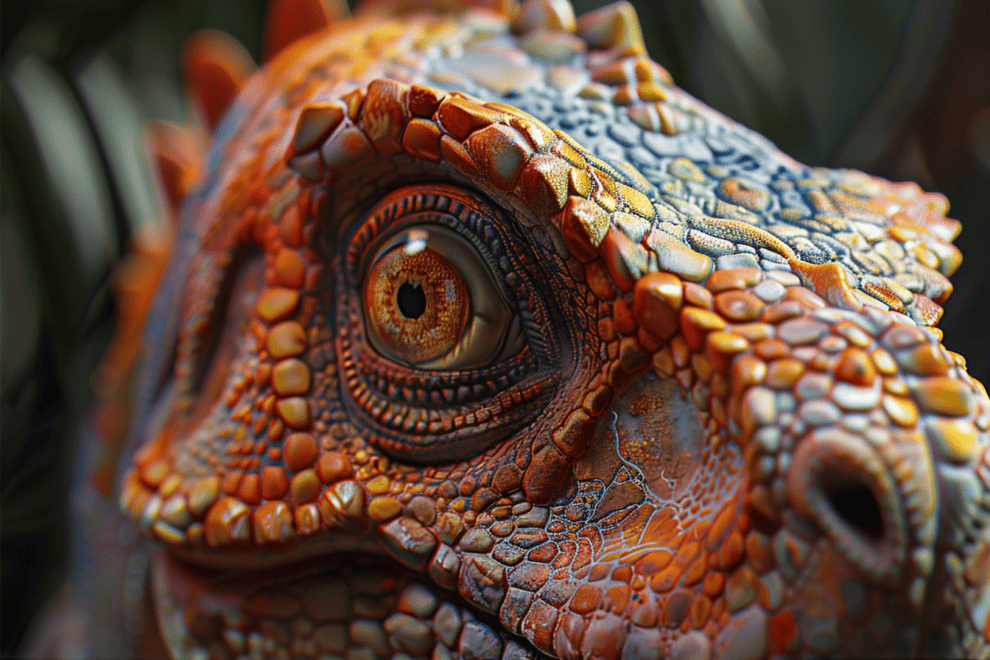Paleontologists have recently made significant strides in understanding the color palette of dinosaurs, revealing a far more vibrant and detailed picture than previously imagined.
Through the study of melanosomes, fossilized pigment structures, scientists have been able to reconstruct a range of hues, from the black feathers of Anchiornis to the reddish-brown plates of Borealopelta.
The work of researchers like Jakob Vinther and palaeoartist Robert Nicholls has shed light on the intricate patterns and colors that adorned these ancient creatures, hinting at their camouflage strategies, social behaviors, and perhaps even their very personalities.
But what other secrets lie hidden in these newly uncovered colors?
Dinosaurs in Technicolor

Scientists have discovered evidence to reconstruct the vibrant colors and patterns of dinosaurs, a dramatic makeover from the original image of dull, scaly creatures. The discovery of melanosomes, tiny pigmentation organelles trapped in fossilized feathers and skin, has revealed the hidden world of dinosaur coloration.
Dr. Jakob Vinther, a palaeontologist at the University of Bristol, has led significant research in this area. He found that melanosomes hold the pigments responsible for colors such as black, reddish-brown, and iridescent hues.
Palaeoartist Robert Nicholls used this data to create life-sized models of dinosaurs like *Psittacosaurus*, demonstrating countershading patterns that suggest a light-colored underside and a darker top. This trend, common in modern animals, aids in camouflage.
The discovery of these color patterns not only enhances our visual understanding but also provides insights into the environments and behaviors of these prehistoric creatures.
Melanosomes and Fossil Color

Jakob Vinther pioneered the study of melanosomes, identifying these tiny pigmentation organelles as the key to understanding the colors and patterns that adorned dinosaurs.
Melanosomes are vital to deciphering the vibrant hues of ancient creatures, as they contain melanin, a strong polymer found in soft-tissue structures. Different melanosome shapes correspond to varying colors: spherical phaeomelanosomes give rise to reddish-brown shades, while rod-shaped eumelanosomes produce dark colors like black and brown.
Fossilized melanosomes have provided a fascinating window into the colorful past of dinosaurs. The discovery of melanosomes in these fossils suggests that many dinosaurs were just as vibrant as modern birds.
For instance, the hadrosaurid Borealopelta was found to have had red and grey coloration, and a counter-shaded pattern. Such patterns, like countershading, were likely used for camouflage, blending these massive creatures into their surroundings.
These groundbreaking findings have allowed scientists to reconstruct the visual appearance of dinosaurs with remarkable precision, painting a bright picture of a technicolored ancient world.
Beyond Melanin Colors

Dinosaurs’ vibrant colors and patterns extended beyond the realm of melanin, as iridescence and other mechanisms played a crucial role in their visual appearance.
For instance, the tiny dinosaur Caihong juji sported iridescent feathers, a trait more commonly associated with modern birds like hummingbirds. This shimmering coloration wasn’t unique to Caihong, as other species like Wulong also displayed iridescent plumage, likely used for intraspecific communication and sexual signaling.
Moreover, some dinosaurs had striking patterns due to melanosomes with different shapes and structures. The armored Borealopelta had a reddish-brown coloration with countershading, indicating it was at risk of predation despite its massive size and protective armor. Sinosauropteryx, on the other hand, wore a raccoon-like mask on its face, complete with a rufous/light brown color scheme and striped tail.
These findings showcase the diverse ways in which dinosaurs adapted and exploited color to survive and thrive in their environments.
Reconstructing Color Patterns

Reconstructing color patterns in dinosaurs relies on careful fossil analysis as researchers decipher clues from melanosomes to recreate ancient hues and patterns. These melanosomes are important because they’re the microscopic blobs of melanin within feathers and scales that determine the coloration of creatures.
By studying the shape and arrangement of melanosomes in fossils, scientists can often infer the original colors of the dinosaur.
One of the most exceptional examples of color pattern reconstruction is the fossil of Sinosauropteryx, which revealed a vivid red-and-white banded tail. This was discovered by examining the pattern of melanosomes within the fossilized feathers.
Similarly, the countershaded pattern on the dinosaur Borealopelta suggests it had a reddish-brown coloration, likely used for camouflage.
For the feathered dinosaur Anchiornis, researchers reconstructed a color pattern featuring gray guts, white wing feathers with black splotches, and a woodpecker-like red crown.
These reconstructions offer a glimpse into the colorful lives of ancient organisms, shedding light on their ecology and social behavior.






